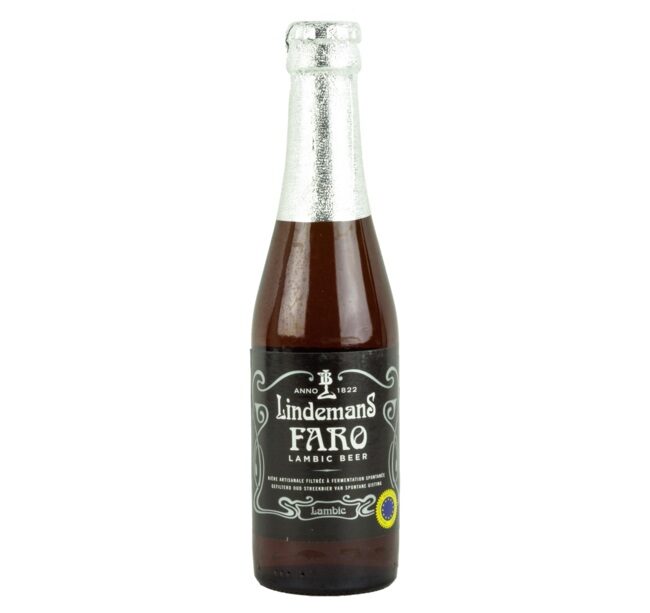Lambic beer is a unique brew that has been around for centuries.
It’s made using wild yeast and bacteria, which gives it a distinct sour taste.
While not everyone may enjoy the flavour of lambic beer, it’s definitely worth trying at least once in your life.
In this article, we’ll explore what makes lambic beer so special, how it’s made, and where you can find it.

The History of Lambic Beer
Lambic beer has a rich history that dates back over 400 years in the Senne Valley near Brussels, Belgium.
Accidental Discovery
The brewing process of lambic beer was discovered by accident when brewers left their wort (unfermented beer) outside to cool overnight.
Controlled Fermentation
Over time, brewers learned to control the fermentation process, resulting in the creation of lambic beer.
Traditional Brewing Methods
Today, lambic beer is still brewed using traditional methods, including open-air fermentation and ageing in oak barrels.
Blending
Blending is also an important part of the lambic brewing process, where young and old lambics are mixed together to create a balanced flavour profile.
- Lambic beer is often blended with fruit to create a sweet and sour flavour, such as cherry (kriek) or raspberry (framboise) lambic.
Unique Characteristics
Lambic beer is unique because it is fermented with wild yeasts and bacteria, giving it a distinct sour taste.
It is also uncarbonated and often served at room temperature.
What Makes Lambic Beer Unique?

One of the things that makes lambic beer unique is its use of wild yeast and bacteria.
Most beers are brewed with specific strains of yeast that produce consistent flavours, but lambic relies on whatever microbes happen to be floating around in the air.
This means that every batch of lambic is different and has its own distinct character.
Wild Yeast and Bacteria
Lambic beer is brewed using wild yeast and bacteria, which gives it a unique flavour profile.
Unlike other beers that use specific strains of yeast, lambic relies on whatever microbes happen to be present in the air. This means that every batch of lambic is different and has its own distinct character.
The wild yeast and bacteria used in lambic beer are typically found in the Senne River valley in Belgium, where the beer originated.
Sour Taste
Another thing that sets lambic apart is its sour taste. This comes from the lactic acid produced by the bacteria during fermentation.
Some people compare the flavour to that of sourdough bread or tart fruit like cherries or raspberries.
While it may take some getting used to, many people find the taste refreshing and complex.
How Is Lambic Beer Made?

The process of making lambic beer begins with creating the wort, which is similar to other types of beer.
However, instead of boiling the wort to sterilise it, lambic brewers cool it down and leave it exposed to the air. This allows wild yeast and bacteria to enter the wort and start fermenting.
Fermentation and Ageing
The fermentation process can take several months or even years. During this time, the beer is stored in oak barrels or other containers that allow oxygen to enter.
The microbes continue to work their magic, producing lactic acid and other compounds that give lambic its unique flavour.
After fermentation is complete, some lambics are blended with younger beers to balance out the sourness and create a more complex flavour profile.
Others are aged for longer periods to develop deeper flavours.
Blending and Bottling
Once the lambic has been aged to the brewer’s satisfaction, it is time to blend and bottle the beer.
Blending is an art form, as the brewer must balance the flavours of different batches to create a consistent product.
Some lambics are also flavoured with fruit or other ingredients at this stage.
Did you know that lambic beer is one of the oldest styles of beer in the world, with a history dating back to the Middle Ages?
After blending, the lambic is bottled and undergoes a secondary fermentation in the bottle. This creates carbonation and gives the beer its characteristic effervescence.
Some lambics are also aged in the bottle for several years to develop even more complex flavours.
Serving and Enjoying
Lambic beer is traditionally served in a special glass called a lambic basket, which allows the sediment to settle at the bottom.
It is also often served with a small amount of fruit syrup to balance out the sourness.
Lambic is a complex and unique beer that is best enjoyed slowly, savouring each sip.
- Fun fact: Lambic beer is one of the few beers that can be aged for decades, with some vintage bottles selling for thousands of dollars.
Types of Lambic Beer
There are several different types of lambic beer, each with its own characteristics:
Gueuze
Gueuze is a blend of young and old lambics that has a dry, effervescent character.
Fruit Lambic
Fruit lambic is lambic that has been fermented with fruit such as cherries, raspberries, or peaches. These beers have a fruity sweetness that balances out the sourness.
Faro
Faro is a sweetened lambic that was popular in the 19th century but is now rare.
Kriek
Kriek is a type of fruit lambic made with cherries and is one of the most popular varieties.
Where Can You Find Lambic Beer?
Lambic beer is primarily produced in Belgium, with a few breweries in other countries also making it. Some of the best-known Belgian lambic breweries include Cantillon, Boon, and Lindemans.
Specialty Beer Stores and Bars
If you’re looking to try lambic beer, the best option is to visit a specialty beer store or bar that specialises in Belgian beers.
These establishments often have a selection of lambics available, including rare and hard-to-find varieties.
Online Retailers
For those who don’t have access to a specialty beer store or bar, there are also online retailers that sell lambic beer.
These retailers often have a wider selection of lambics available, including vintage and limited edition varieties.
Some online retailers even offer lambic beer clubs, where members receive a selection of lambics delivered to their door on a regular basis.
Brewery Tours
Those who want to experience lambic beer straight from the source, many of the Belgian lambic breweries offer tours.
These tours often include tastings of the brewery’s lambics and provide a unique opportunity to learn about the brewing process.
Some breweries, such as Cantillon, only offer tours by appointment, so it’s important to plan ahead.
Beer Festivals
Beer festivals, particularly those that focus on Belgian beers, are another great place to try lambic beer.
These festivals often feature a wide variety of lambics from different breweries, providing a unique opportunity to sample and compare different styles.
Some of the most well-known beer festivals that feature lambic beer include the Brussels Beer Weekend and the Zythos Beer Festival.
The Benefits of Drinking Lambic Beer

If you are looking for a unique and refreshing beer experience, lambic beer may be worth a try.
With its distinct flavour and lower alcohol content, it offers several benefits.
Unique Flavour
Lambic beer provides a refreshing change of pace for those tired of the same old beers. Its unique flavour comes from the spontaneous fermentation process, which gives it a tart and fruity taste.
Low Alcohol Content
Most lambics have an alcohol content of around 5%, making them a good choice for those who want to enjoy a beer without getting too tipsy.
This also makes them a great option for daytime drinking or for those who prefer a lighter beer.
Probiotic Properties
Because lambic is fermented with bacteria, it contains probiotics that can help support gut health. These probiotics can aid in digestion and boost the immune system.
How to Enjoy Lambic Beer
If you’re new to lambic beer, here are some tips on how to get the most out of your experience:
Serve at the Right Temperature
Lambic should be served slightly chilled but not cold. Aim for a temperature between 50 and 55 degrees Fahrenheit.
Use the Right Glassware
A tulip or wine glass is best for lambic, as it allows you to fully appreciate the aroma and flavour.
Pair with Food
Lambic pairs well with a variety of foods, including cheese, charcuterie, and seafood.
The Future of Lambic Beer
As craft beer continues to grow in popularity, we can expect to see more interest in unique styles like lambic.
While it may never become as mainstream as IPAs or stouts, there will always be a dedicated group of fans who appreciate its complex flavours and rich history.
Lambic beer is a truly unique brew that deserves to be experienced by anyone who loves beer.
Whether you’re a seasoned beer connoisseur or just looking to try something new, lambic is definitely worth seeking out.
With its wild yeast, sour taste, and centuries-old brewing tradition, it’s a beer like no other.
Conclusion:
In conclusion, Lambic beer truly deserves a spot on every beer enthusiast’s must-try list.
From its rich history, unique brewing process, and distinct flavor profile, Lambic beer offers an unforgettable tasting experience that sets it apart from other brews.
Whether you’re a fan of fruity flavors or seeking something more traditional, this versatile beverage caters to a wide array of taste preferences through its various styles, such as Gueuze, Kriek, and Framboise.
Moreover, exploring the world of Lambic beer not only tantalises your taste buds but also allows you to delve into the fascinating Belgian beer culture.
So next time you have the opportunity, don’t hesitate to discover the magic of Lambic beer – it just might become your new favorite brew
FAQs About Lambic Beer
Q: What kind of beer is a lambic?
A: Lambic beer is a type of beer that is spontaneously fermented using wild yeast and bacteria found in the air of the Senne River valley in Belgium.
Q: What does lambic beer taste like?
A: Lambic beer has a unique taste that is often described as tart, sour, and slightly funky, with a distinct fruity and earthy character.
Q: Is lambic a sour beer?
A: Yes, lambic beer is considered a sour beer due to its natural fermentation process that produces lactic acid and acetic acid, giving it a sour taste.
Q: Why is lambic beer so expensive?
A: Lambic beer is expensive due to its labour-intensive production process, lengthy ageing time, and limited availability. It also requires specific brewing equipment and can only be produced in certain areas of Belgium.
Q: What is the difference between lambic beer and ale?
A: The main difference between lambic beer and ale is the fermentation process. Lambic beer is fermented using wild yeast and bacteria, while ale is typically fermented using a specific strain of brewer’s yeast.
Q: What is the difference between lambic and sour beer?
A: Sour beer is a broad category that includes lambic beer as well as other types of beer that are intentionally soured using bacteria or yeast. Lambic beer, however, is unique in that it is spontaneously fermented using wild yeast and bacteria found in the air.
Q: Is lambic beer healthy?
A: While there are no inherent health benefits to drinking lambic beer, moderate alcohol consumption (including lambic) has been linked to certain health benefits when consumed as part of a balanced diet and lifestyle.
Q: What is the alcohol level of lambic?
A: The alcohol level of lambic beer is typically low, ranging from 4% to 6% ABV (alcohol by volume).
Q: Do you drink lambic cold or at room temp?
A: Lambic beer is traditionally served at cellar temperature, which is around 50 to 55 degrees Fahrenheit. It is not typically served cold, as this can diminish its complex flavours and aromas.
